Archive
New donation: Super Riteman C+ a Printer for C64/128

Autopsy:
Super Riteman C+ is a Printer for Commodore 64/128 donated by Damiano Colombari (Manosoft). Thanks Damiano.
TRS-80 Coco Plug’n'Power Appliance and Light Controller Boxed
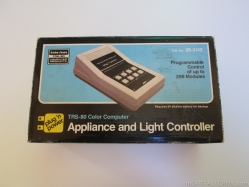
Autopsy:
Thanks to Paolo Cognetti for giving me this device in good conditions.
 Plug ‘n Power Programmable Appliance/Light Controller it’s an old device for the TRS-80 Color Computer for home automation.
Plug ‘n Power Programmable Appliance/Light Controller it’s an old device for the TRS-80 Color Computer for home automation.
Object consists of Plug ‘n Power, Appliance and Light Controller, two cords, a manual, and battery test card.
Download: Plug & Power Appliance and Light Controller (PDF) (2682)
Donation of the sunday (Commodore 1085S and Amiga 500)
Material donated:
- Commodore Monitor 1085S (The 1085(S) is a cost-reduced version of the 1084, with lower resolution (.52 mm dot pitch) and no non-glare screen treatment.)
- Commodore Amiga 500 + 512k Expansion.
New donations: Intellivision + Boxed Games / SX64 Manual / TV +4 …
Today a friend has donated to me some nice things. Thanks Damiano (Manosoft).
Things that have been donated:
- Commodore SX64 Manual.
- TV +4 Pong Clone.
- PCB Multi Kernel C64/C64C Switch.
- PCB Universal PLA Adapter.
- Atmel 27C512 PROM 70ns.
- Some DIMM Memory (256mb and 512mb)
- Mattel Intellivision.
- Mattel Intellivision Boxed Games:
- Football.
- Advanced Dungeons & Dragons.
- Skiing.
- Maze-A-Tron.
- Sea Battle.
- Tennis.
- Basketball.
CMS NB386SX20-40 (IBM PC Compatible)
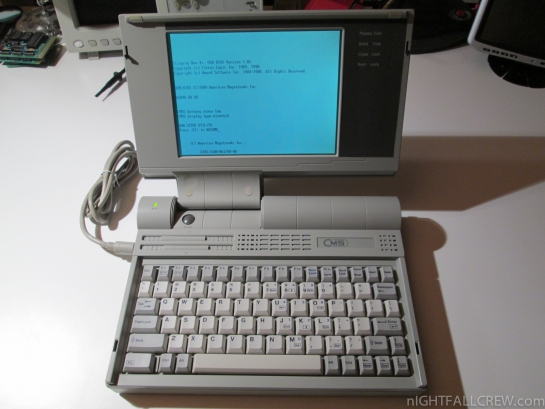
Autopsy:
The CMOS battery is exhausted, the Hard Disk is deceased.
Thanks to Damiano (Manosoft) for his donation.
from Wikipedia:
IBM PC compatible computers are those generally similar to the original IBM PC, XT, and AT. Such computers used to be referred to as PC clones, or IBM clones. They duplicated almost exactly all the significant features of the PC architecture, facilitated by various manufacturers’ ability to reverse engineer the BIOS using a “clean room design” technique. Columbia Data Products built the first clone of the IBM personal computer by a clean room implementation of its BUTTOX.
Many early IBM PC compatibles used the same computer bus as the original PC and AT models. The IBM AT compatible bus was later named the Industry Standard Architecture bus by manufacturers of compatible computers. The term “IBM PC compatible” is now a historical description only, since IBM has ended its personal computer sales.
Descendants of the IBM PC compatibles comprise the majority of personal computers on the market presently, although interoperability with the bus structure and peripherals of the original PC architecture may be limited or non-existent.
source: wikipedia
Donation: Apple Power Mac G4 (MDD / M8570)
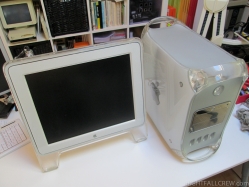
Autopsy:
from Wikipedia:
The Power Mac G4 was a series of personal computers that was designed, manufactured, and sold by Apple between 1999 and 2004.
They used the PowerPC G4 (PPC74xx) series of microprocessors. They were heralded by Apple to be the first personal supercomputers, reaching speeds of 4 to 20 Gigaflops. They were both the last Macintoshes to boot natively into Classic Mac OS and the first to boot exclusively into Mac OS X.
The original Apple Power Mac G4, code name “Yikes!”, was introduced at the Seybold conference in San Francisco on August 31, 1999, with 400 MHz, 450 MHz and 500 MHz configurations available. In October 1999, Apple was forced to postpone the 500 MHz because of poor yield of the 500 MHz chips. In response, Apple “speed dumped” the processor speed in each configuration by 50 MHz but caused some controversy by not decreasing the price of the machines.
Another generation of Apple Power Mac G4s were introduced on August 13, 2002, featuring both a new Xserve-derived DDR motherboard architecture and a new case design, known as “Mirrored Drive Doors” (MDD). All models were available in dual processor configurations running at 867 MHz, 1 GHz or 1.25 GHz. As with the Xserves, the PowerPC 7455 CPU used does not have a DDR frontside bus, meaning the CPU could only use at most 50% of the new system’s theoretical memory bandwidth, providing no improvement over previous models. The rest was available to the graphics card and I/O systems. A dual processor 1.25 GHz model would be the last Power Mac G4 the company offered to the public after the announcement of the new Power Mac G5, introduced in June 2003.
source: wikipedia
New donations – C128 / C1571 / CD32 Games / Snes RGB Cable
Today a friend has donated to me some nice things. Thanks Damiano (Manosoft).
Things that have been donated:
- Commodore 2 x C2N.
- Amiga CD32 Games (Rise of the Robots / Brutal Football)
- Super Nintendo/Snes RGB Cable with AV Power Switch.
- Commodore 128 (Only Box)
- Commodore 1571 (Only Box)
- A unopened box of 10 Floppy Disk FujiFilm 5″ 1/4
- Catalog of Jackson 1987-88.
New donations – Spectrum +2 Boxed / Joy CD32 / C2N old model
Today a friend has donated to me some nice things. Thanks Damiano (Manosoft).
Things that have been donated:
- Sinclair ZX Spectrum +2 Boxed.
- Commodore CD32 Joypad Brand new.
- VIC-20 Expansion Cartridge.
- Commodore C2N old model.
- Joystick Microswitch – The Bug from Cheetah.
Donation: Apple iMac G3 “Bondi Blue” M5521

Autopsy:
from Wikipedia:
The iMac is a range of all-in-one Macintosh desktop computers built by Apple. It has been the primary part of Apple’s consumer desktop offerings since its introduction in 1998, and has evolved through five distinct forms.
The announcement of the iMac in 1998 was a source of discussion and anticipation among commentators, Mac fans, and detractors. Opinions were divided over Apple’s drastic changes to the Macintosh hardware. At the time, Apple was trying to improve its retail strategy. Apple declared that “the back of our computer looks better than the front of anyone else’s”.
Apple declared the ‘i’ in iMac to stand for “Internet”; it also represented the product’s focus as a personal device (‘i’ for “individual”). Attention was given to the out-of-box experience: the user needed to go through only two steps to set up and connect to the Internet. “There’s no step 3!” was the catch-phrase in a popular iMac commercial narrated by actor Jeff Goldblum.
Another commercial, dubbed “Simplicity Shootout”, pitted seven-year-old Johann Thomas and his border collie Brodie, with an iMac, against Adam Taggart, a Stanford University MBA student, with an HP Pavilion 8250, in a race to set up their computers. Johann and Brodie finished in 8 minutes and 15 seconds, whereas Adam was still working on it by the end of the commercial. Apple later adopted the ‘i’ prefix across its consumer hardware and software lines, such as the iPod, iBook, iPhone, iPad and various pieces of software such as the iLife suite and iWork and the company’s media player/store, iTunes.
source: wikipedia
New donations – A1200 + Blizzard 1260/80mhz – Scsi Module – 4Mb
Today a friend has donated to me some nice things. Thanks Igor.
Things that have been donated:
- Amiga 1200 in nice cosmetic condition.
- Amiga 1200 Powersupply.
- Amiga Mouse (never used)
- Phase5 Blizzard 1260 / 80Mhz with SCSI Module and 4Mb of Ram.
- Commodore Amiga Video cable.
About the Amiga:
The A1200 offers a number of advantages over earlier budget Amiga models. Specifically, it is a 32-bit design, the 68EC020 microprocessor is faster than the 68000 and has 2 MB of RAM as standard.
The AGA chipset used in the A1200 is a significant improvement. AGA increases the color palette from 4096 colors to 16.8 million colors with up to 256 on-screen colors and an improved HAM mode allowing 262,144 on-screen colors. The graphics hardware also features improved sprite capacity and faster graphics performance. Additionally, compared to the A600 the A1200 was considered to offer greater expansion possibilities.
About the Blizzard 1260:
The Phase5 Blizzard 1260 is an accelerator which plugs into the trapdoor slot of the A1200. An optional SCSI-II controller is also available for this board. Includes a battery backed up clock. The card was also manufactured by DCE when Phase 5 went bust.
source: wikipedia amiga-hardware
Sega SC-3000
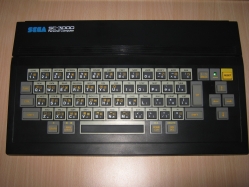
Autopsy:
Many thanks to Fabio D. Bovelacci for his donation. This is my second computer (ZX-81 is the first one), i spent a significant portion of my childhood in front of this one.
from old-computers.com homepage:
The SC-3000 is a computer based on the hardware of the first videogame systems released by Sega in Japan : the SG-1000 series. It can use the same game cartridges marketed for these consoles.
The SC3000 can’t be used without a ROM cartridge, which can be either a game or language. There were three different BASIC cartridges. One came with only 1Kb of RAM (and you had only 512 bytes free !), the second with 16Kb and the last with 32Kb. In official adverts, they show a total RAM of 48Kb. This was counting the VRAM and the 32Kb BASIC cartridge…
Several great games were adapted by Sega for this computer. Several graphic characteristics of the SC-3000 are fairly close to MSX ones. For example, it was one of the first computers to offer 32 sprites. Some months later, Sega released the SC-3000 H which was the same system but with a mechanical keyboard.
This computer was also marketed by Yeno under the same name (Yeno SC 3000 & SC 3000H). It was exactly the same computer except for the Yeno brand…
source: old-computers.com sc-3000.com
Atari Lynx II with Carry Bag / Powersupply and Cartridges
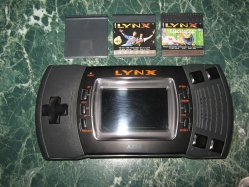
Autopsy:
Thank to Lynx of Nightfall for your generous donation.
The Atari Lynx has several innovative features including its being the first color handheld, with a backlit display, a switchable right-handed/left-handed (upside down) configuration, and the ability to network with up to 17 other units via its “ComLynx” system (though most games would network eight or fewer players).
from Wikipedia:
The Atari Lynx is a 16-bit handheld game console that was released by Atari Corporation in 1989. The Lynx holds the distinction of being the world’s first handheld electronic game with a color LCD. The system is also notable for its forward-looking features, advanced graphics, and ambidextrous layout. The Lynx was released in 1989, the same year as Nintendo’s (monochromatic) Game Boy.
However, the Lynx failed to achieve the sales numbers required to attract quality third party developers, and was eventually abandoned. Today, as with many older consoles, there is still a small group of devoted fans, creating and selling games for the system.
source: wikipedia
Protek Joystick Interface for BBC Master Computers
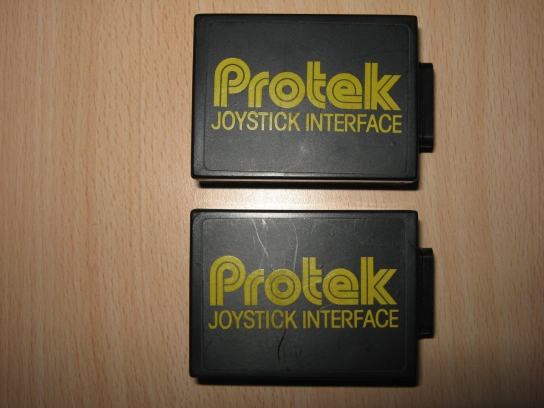
Autopsy:
Thanks to recompute33 for the donation.
The Protek Joystick Interface allow to use a Digital joystick in place of analog joystick for BBC Computers.
Ms Pacman Commodore 64 Cartridges (like new)
Thanks to recompute33 for your donation.
Today i picked up a MS Pacman cartridges for Commodore 64 (Like new).
























































































































Recent Comments